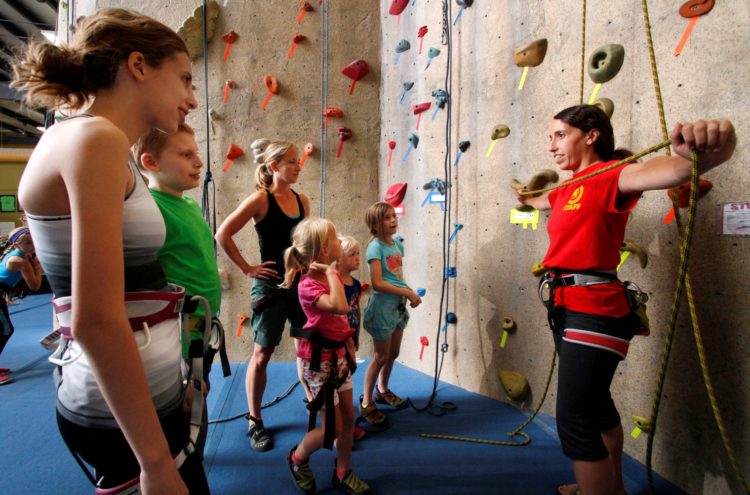Hanging onto a small blue ledge with his fingertips, the toned young man hoists himself up with a muscle-straining pull of his arms and stretches to grab the next handhold. This one happens to be a lime green “jug,” shaped so his fingers can fit over its lip for a positive grip.
“You see what I did there?” he asks, looking at me over his shoulder. “I pulled myself up with my arms, which is a common mistake that beginners make. You’ll get a lot more power and use less energy if you climb using your legs.”
Robby Stack hops down to the padded floor and then climbs back onto the lowest holds on the wall with the practiced ease of a mountain goat. He shifts his left foot so that it’s pressed up against the 40-foot artificial cliff face.
“Another common mistake is to only use your toes,” he says. “I shift my feet and hips all the time to keep in contact with the wall.” As a result, Stack explains, you stay more upright and stable, with less body mass trying to pull you backwards into the open air.
Of course, this is getting into Rock Gym 102 material. We’ve just reached the end of our Rock Gym 101 course at Upper Limits West County, and Stack is giving me a little sneak preview at what lies ahead. Call it “journalist’s privilege.”
In the two-hour Rock Gym 101 class, we’d covered top-rope climbing — where the climber has a rope running from his or her harness, up to an anchor at the top of the wall and then back down to a belayer, who keeps the rope taut to protect from falls — as well as basic safety procedures and equipment usage. And knots, lots of knots.
If you’re intrigued by rock climbing and have never been to Upper Limits West County or its sister locations in downtown St. Louis or Bloomington, Ill., you owe it to yourself to go. With 14,500-square-feet of climbing surface, including two massive arches and a rope-free boulder for technique work, it’s like a multicolored playground for adults.
In fact, statistics show that indoor climbing has been on a big upward trend since the early 2000s. And why shouldn’t it be? Not only is it a fantastic mental and physical workout (take my word for it), but it’s social, it’s accessible, and it’s a great way to “graduate” people to outdoor climbing.
Still, indoor climbing, and climbing in general, can be intimidating. That’s why we asked Lindsey Schaefer, Upper Limit’s marketing manager, to give us a rundown of some of the misconceptions and need-to-knows about indoor climbing, so that more people can get their feet off the ground and into an exciting new sport.
1. Climbing isn’t just for the super-fit. “Contrary to popular belief, you don’t have to be in top physical condition or have a lot of upper body strength to climb,” says Schaefer. Rock climbing builds the body’s strength over time and is ideal for enhancing muscle tone and increasing flexibility.
2. There are two types of climbing that can be done in an indoor environment: bouldering and roped climbing. Bouldering is climbing that is done close to the ground without the use of a rope. “Climbers can boulder problems — essentially short mini routes — without a partner. Bouldering is excellent for building strength, power, and technique,” says Schaefer. Top Roping and lead climbing are two common forms of roped climbing, which allows you to safely climb higher, more vertical surfaces.
3. Use your legs! Relying on upper-body strength to pull yourself up is a common beginners’ mistake. Instead of pulling your weight up the wall with your arms, you should step up as much as possible with your legs to push your weight up the wall. This will help conserve energy, so you can climb longer.
4. The belayer is the person on the ground holding the safety end of the rope for the climber. It’s the belayer’s job to stop the fall of the climber. Upper Limits offers several introductory classes each week (Rock Gym 101) to teach you how to tie the necessary knots, use the climbing equipment, and belay for a climber.
5. Rock climbing doesn’t cost a ton of money. All you really need in the beginning is a harness, climbing shoes, chalk, and a belay device. “When you start climbing in the gym, you can rent the equipment that you need, but if you fall in love with climbing, you’ll probably want to get your own,”says Schaefer.
6. A fear of heights should not prevent you from rock climbing. “Every precaution we take as climbers, including tying into the rope, clipping the rope to anchors in the rock, and using belay devices to hold the rope and safeguard a climber, is to protect you from the consequences of falling,” says Schaefer. “If you climb enough, you’ll eventually get over your fear of heights and hopefully begin to relish the views that you find from the top.”
Upper Limits offers a full schedule of classes, as well as special programs and membership packages, that include introduction to climbing, advanced technique and sport (lead) climbing, multi-pitch climbing, anchoring, and even proper falling. Get more information at www.upperlimits.com.
Author: Brad Kovach is the editor of Terrain magazine.
Image: Courtesy of Upper Limits.


Leave A Comment